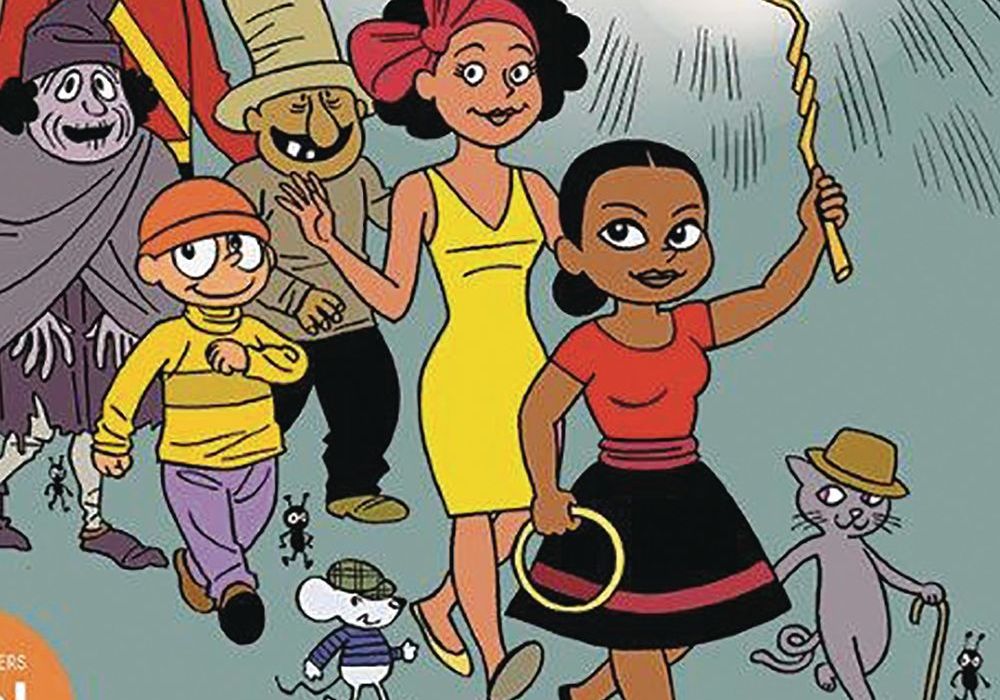With so much great all-ages content out there and more arriving every week, whether you’re a parent, teacher, librarian or young reader, sifting through it all can be a daunting task. Of course, tastes and reading lists are subjective and even change over time. With an ever-growing collection of newly released and classic books, Multiversity’s Bookshelf Basics is designed not only to give you a place to start, it’s somewhere you can return to as your tastes and interests change. In today’s installment, we look at “The Dragon Slayer: Folktales from Latin America,” the first foray into all-ages content by the legendary Jaime Hernandez, co-creator of “Love and Rockets.”
Written and Illustrated by Jaime HernadezCover by Jaime Hernandez
Colored by Ala LeeA fresh take on timeless tales! How would a kitchen maid fare against a seven-headed dragon? What happens when a woman marries a mouse? And what can a young man learn from a thousand leaf cutter ants? Famed Love and Rockets creator Jaime Hernandez asks these questions and more as he transforms beloved myths into bold, stunning, and utterly contemporary comics. Guided by the classic works of F. Isabel Campoy and Alma Flor Ada, Hernandez’s first book for young readers brings the sights and stories of Latin America to a new generation of graphic novel fans around the world.
Okay, Let’s Start with the Basics
“The Dragon Slayer: Folktales from Latin America” consists of three separate stories, two of which feature strong female protagonists. Interestingly, though the original source material harkens back to traditional folk and fairy tales that were passed down orally from one generation to the next, the versions presented here are based on previously published works. Nonetheless, with Hernandez’s streamlined text and charming illustrations, these immediately accessible versions are new and different from anything else you may have seen. Naturally, you’ll be tempted to dive right into the stories, but whether you read it first or come back to it later, F. Isabel Campoy’s introductory essay, “Imagination and Tradition,” succinctly contextualizes and re-centers these tales, adding additional layers of insight and enjoyment.
What’s It All About?
Each of the three stories is quite unique and distinct, unified by Hernandez’s deceptively simple illustrations that keep virtually every panel focused on the characters’ emotions, facial expressions and body language. In “The Dragon Slayer,” which opens the book, a young woman proves to be selfless, brave and ingenious. For her, slaying the dragon is only a start. Ultimately, she goes on to flip the script and save her prince in battle and call the king to account for going back on his word. In “Martina Martínez and Pérez the Mouse,” the titular characters marry each other, only to narrowly avoid tragedy when Pérez falls into the soup pot and everyone seems more concerned with broadcasting their sympathy than actually doing anything about it. Finally, in “Tup and the Ants,” the proverbial diminutive youngest son shows his parents that he’s anything but the “lazy bones” they perceive him to be. By recruiting ants as allies, he proves to be more efficient and far more effective than his bigger, stronger brothers, producing a bumper crop of epic proportions.
What Makes It Essential?
Quite simply, this is visual storytelling at its best, clearly designed for young readers, simple and easy to follow. The backgrounds, for example, are remarkably clean and uncluttered, giving the scenes just enough context to establish a clear sense of time and place. Similarly, the paneling is straightforward and unassuming, giving younger readers a steady, predictable rhythm. Virtually every page consists of six equally weighted panels, with the occasional use of five. In either case, the flow is crystal clear and consistent; intuitive and effortless. In fact, as one moves through the various pages and panels, the sense of motion is seamless, evoking classic Saturday morning cartoons or a well made flip book. With each turn of the page, you can see the story unfold before your very eyes.
Beyond all of that, Hernandez’s character designs are basically flawless, if not iconic. With clean lines and solid colors, big eyes and expressive faces, they immediately draw you into the story. Whether protagonist or villain, main character or bit player, there is an immediate connection that feels almost palpable, despite their whimsical look and feel. To call them “bigger than life” is not quite accurate. There is a feeling, as Campoy suggests, that we are “in the homes of common folk solving real-world problems,” but it’s also more than that. The characters are transcendent. Timeless. Existing on a plane above and beyond “the real world” in the fanciful realm of the imagination where anything seems possible.
Continued belowHow Can You Read It?
“The Dragon Slayer: Folktales from Latin America” is available in both hardcover and softcover, in both English and Spanish editions, with translation by María E. Santana. Of course, not every version is available at every retailer, but you can always order directly from the publisher, Toon Books, a consistently outstanding source of all-ages comics, especially for very young readers.
In Conclusion
Legendary comics creator Jaime Hernandez brings his considerable talents to bear in this exceptional collection of reimagined Latin American folktales. With incredible character designs, bold colors and clean, straightforward scripts, this is cartooning at its finest. Corral a little one, sit down together and share these stories. You will be glad you did.




